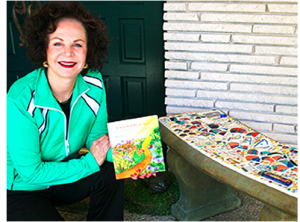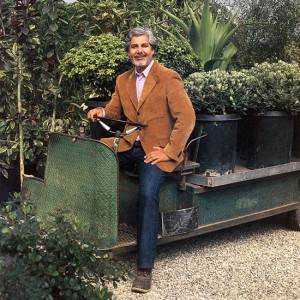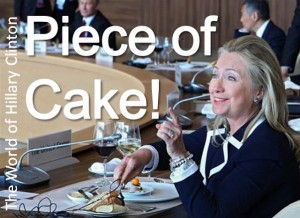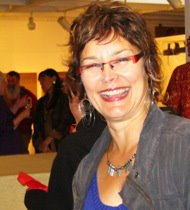
Joseph E. Holland, courtesy photo
With three elections scheduled in Santa Barbara County this year–including the presidential primary on February 5–one would think that the county’s election chief Joseph E. Holland has his hands full. The elections office staff of 12 will ramp up to about 1,200 by Election Day. Luckily, he’s used to multi-tasking. County Clerk, Recorder and Assessor since 2003, Holland manages a $13 million budget and four divisions: Assessor, Elections, Recorder and Information Services.
Leslie Dinaberg: This is a big year for you guys with the early presidential primary, the spring primary and then the presidential election. What does that mean for your office in terms of work?
Joe Holland: …Most people don’t understand how complicated elections really are, which is good, that’s what we strive for. People want to come in, vote their ballot and have their ballot counted…that’s all that they need to worry about or need to think about. But behind the scenes, it starts with voter registration. When you register to vote, you, of course, register by your address and that determines what type of ballot you will have. What jurisdiction you are in. Are you in the city of Santa Barbara, the Goleta Water District, what congressional district are you in? It’s a lot of work just making sure that every one of the 183,000 registered voters gets the proper ballot on election day…that’s where the first level of complexity starts.
Then…you’re designing the ballots…we handle candidate filing. You’re making sure that all the candidates are properly signed up for their office …we have to hire poll workers, we have to calibrate voting machines, we have to deliver polling supplies, and we have to train poll workers…We have 215 precincts at the polling places and so…there’s nine hundred to 1,000 poll workers you have to hire across the county.
LD: Do you try to get the same people for each of the three elections?
JH: Yes we try to and a lot of them will work for all three elections. You know that’s quite a challenge … with these three major elections in 2008 it means we have to do all this work three times and that’s the first time we’ve ever had to do that…. Three major, statewide elections in one calendar year, I think this is the first time in history that’s ever happened…
LD: That’s a big job.
JH: …Most people don’t understand, but we send out ballots 60 days before the election to overseas voters in the military, so really although everybody knows the election is February 5th, it really started for us December 5th.
LD: Speaking of absentee ballots, how many permanent absentee voters are there?
JH: There are 90,000. …
LD: Are there any cost savings when people vote by mail?
JH: No, because we’re running two elections. We’re actually running a poll-based election and a mail ballot election. As long as we’re doing both, it really isn’t saving us any money because I still have 215 precincts and I still have to hire poll workers for all of those precincts. So it really doesn’t save money, it actually costs more money, but it does lead to a higher voter turnout because it makes voting easier.
LD: What is the rate of return of people that register to vote by mail versus the other registered voters?
JH: …If you look on average over the last 13 countywide elections…75 percent of people who receive a ballot in the mail return their ballot. For those people that vote at the polls, on average, 50 percent return. …The more people I can get to vote by mail the higher turnout I’m going to have…the turnout in Santa Barbara County has been going up.
LD: That’s good. I would assume that the presidential election years are typically a much better turnout than the off years.
JH: Yeah. In November 2004 we had an 80.5 percent turnout in Santa Barbara County. That was the highest turnout since 1976. … For this primary election, here we are as of January 11th, we’ve had the Iowa Caucus and the New Hampshire primary and it looks like both the Democratic and Republican contests are still very much undecided, wide open.
In March 2004 we had a 55 percent turnout for the presidential primary, but it was pretty much decided by March 2004 who was going to be the nominee for both major parties.
LD: It will be interesting to see how long it takes to come to a consensus.
JH: This ballot doesn’t have senate, congress, state legislature, all that March 2004 did have. So what going to happen on February 5th? My guess is it’s going to be a very big turnout….I’m going to guess it’s definitely going to be higher than 55 percent. It probably won’t be as high as 80 percent but it might approach 70 percent.
LD: When you’re in your crunch time, do you have deputies in the other areas you’re responsible for, that you can delegate more stuff when there’s an election going on?
JH: Yes. I have excellent staff…they do a great job so I spend my time doing this kind of stuff (interviews). And I sit in meetings and have them report to me and make decisions.
You know what’s fun? On Election Day, I actually drive around to all the various precincts, check on all the poll workers, and that’s a lot of fun.
LD: I would imagine you probably have some poll workers that have been doing it for years.
JH: Oh yeah. It’s great to go see them every Election Day. What I like about elections is they are so positive. People are there because they want to be there. Because they want to vote because they want to make a difference. And even the poll workers, they are there because they want to be part of this making a difference, and it’s pretty exciting.
LD: It’s fun. We always like to take our son, who is 8. He loves to go and get the little sticker.
JH: You know that’s the one thing about vote by mail, you don’t get the sticker. I love those stickers.
LD: I love the efficiency of it and the convenience of voting by mail, but there’s something kind of nice about going in there and casting your vote.
JH: I’m not vote by mail, so I vote at the polls. …That way, I get all the candidates materials mailed to me all the way up to Election Day. If you just vote by mail and you turn in your ballot they stop sending you stuff.
LD: That’s efficient data management. You must have really powerful technology to manage all the data.
JH: It starts with the vote registration database, 180,000 registered voters. We anticipate that we’ll probably get a good amount of people registering to vote before January 22nd, which is the last day to register to vote.
If you look back to 2004, we got 25,000 new registrations right before the November 2004 election. So how do you process 25,000 voter registration applications? It’s quite an undertaking. We had a whole bunch of people working late at night trying to get that done by the deadline. Now we’ve got what’s called ICR, intelligent character recognition, so when you fill out your voter registration card, you’ve hand written all of your data in there. We actually can scan that in and this machine will read your handwriting. … We don’t have to do that data entry. So what we’re hoping is that this presidential year if we get a whole bunch of those in, it’s going to go much quicker because all they’re doing is just verifying what’s right.
LD: Sounds pretty high tech.
JH: When you return your absentee ballot you sign the outside of the envelope, and there’s a bar code on there that tells us who you are. So when we receive that envelope back, we send it through a machine that’s called an ASR, automatic signature recognition machine. It goes through, it tells us that we’ve received Leslie’s ballot on this date at this time, and that it compares your signature with the signature that we have on file for you with your voter registration card, and if it matches, then it accepts it.
…(Before June we’ll have a new technology so that) when your ballot is received you’ll be able to go on the Internet and type in your name and it’ll tell you whether or not your ballot was received and on what day. So if you’re voting by mail you can verify that indeed our ballot made it to our office.
…Another machine that we have for the first time this year is we have an automatic envelope opener. … We get all these ballots that are accepted, ready to go. Now we need to open them. We used to hire a whole bunch of extra people to sit around a big table and just open the envelopes.
LD: Sounds like a lot of carpal tunnel.
JH: Yeah. This year we have a machine that actually can do 5,000 envelopes an hour and will open them on three sides, lay out the envelope, and plop the ballot into a bin. And by opening up three sides of the envelope, … the reason why you need to do that is to make sure that you didn’t leave any ballots inside of an envelope.
… The average voter should not be thinking about these things. They don’t need to, we’re thinking about them, because if there was a close race and two or three ballots were stuck in those envelopes, then that’s not good.
LD: When do they start tabulating the vote by mail ballots?
JH: We can start opening and processing them and tabulating them ten days before the election. We have a secure room that’s behind glass walls, with video cameras in there, with security cameras, and the public is welcome to come watch this process. We’ll actually start running ballots through vote tabulation machines and then in another room we have the computer that has place where those results will go. Now no one can look at the results but then on election night we will…. every ballot that we have in our hands prior to Election Day is tabulated and the results go up on the Internet at 8:05 on election night.
LD: That’s definitely a change with the technology. I can remember when they would be counting absentee ballots for days after an election.
JH: It’s a huge change. …
LD: What is the approximate cost to the county for each of the three elections?
JH: Each one will cost roughly a million and half dollars. The primary election, the special primary election that the state legislature added statewide, that’s probably costing $100 million. The estimates have been up to $100 million.
… The governor did say …that the state intends to reimburse the counties for it…however we’ve been looking through the budget and we can’t find where he put the money in.
But remember the statewide special election in 2005; they did not fund that ahead of time. They waited until all the costs came in and then they funded it. So we’re hoping that this will be reimbursed similarly.
LD: But just the February election?
JH: Right.
LD: Do you still like this job?
JH: Oh yeah, it’s a lot of fun. It’s a little scary because we’re only human and you know people are going to make mistakes and there’s not a whole lot of room for mistakes when you’re running elections. We just knock on wood. We have made mistakes but nothing serious and we’re doing everything we can to see that it doesn’t happen, but you know, we’re human.
LD: Can you tell me a little about the other things you do, besides elections?
JH: As recorder we record all official records, grant deeds, trust deeds, when you buy a house. … Birth and death certificates. … I’m the civil marriage commissioner…we issue passports and we do that in three offices, Santa Barbara, Santa Maria and Lompoc, which is very unique. I don’t know that there are any other counties that do that.
…Then as assessor, which is my other hat, I describe and assess all taxable property in the county of Santa Barbara.
LD: What are the property taxes looking like?
JH: We have a $57 billion assessment right now for the county and with the current foreclosure situation; the increase in the assessment is not as high as it’s been in the last few years. It’ll still be an increase. We may go to three or four percent increase this year. Last year it was seven percent. Two and three years ago it was ten, eleven percent. It you multiply that by $55 billion that’s a lot of money.
The county right now is facing layoffs because the property tax assessment is not going up as high as it was in the previous years. That plus the fact that they had to make some adjustments in retirement that is causing layoffs.
…I lowered the assessment on 7,000 houses last year because of the economy. These are people that bought at the height of the market and their house is no longer worth what it’s assessed at. So I went out and all my staff went out under my direction, and we identified those 7,000 homes and we lowered their assessment to the fair market value as of January 2007. We’re going to do the same thing this year as of January 1, 2008 and my guess is the number of homes we’re going to lower the assessment on may go up to as much as 15,000. It’s mostly in the north county. Places in the south county such as Hope Ranch and Montecito have not gone down in value, at all, they continue to go up.
LD: That’s another tough job. What do you do when you’re not working?
JH: I’m involved with the Courthouse Legacy Foundation … there are some areas of the courthouse where there really has been some severe degradation of the actual structure where it has fallen into disrepair. It’s too beautiful to ignore and have it fall apart. …This courthouse legacy foundation is hopefully a vehicle that can take private and public and mix the two together and try to come up with solutions.
LD: When you do get the time to relax, what do you like to do for fun?
JH: My daughter Michelle plays water polo for Dos Pueblos. …I like to go watch her play sports. That’s a blast.
Vital Stats: Joe Holland
Born: April 24, 1957 in Los Angeles
Family: Wife Kathy and children Scott (21), Bridget (20) and Michelle (14)
Civic Involvement: Courthouse Legacy Foundation, United Way Board of Directors
Professional Accomplishments: Elected to the Office of the Clerk, Recorder, and Assessor in 2002; former Audit Section Supervisor and Real Property Appraiser for Santa Barbara County
Little-Known Fact: Joe met his wife Kathy when he was a student at UCSB and they were both working at Vons on Turnpike Avenue.
Originally published in Noozhawk on January 28, 2008. Read the original story here.
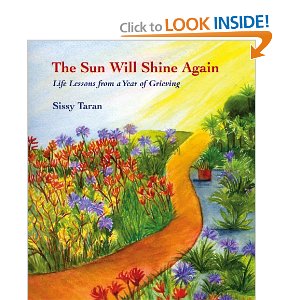 ith Sunday afternoon at a special event honoring the publication of Sissy Taran’s new book, The Sun Will Shine Again: Life Lessons from a Year of Grieving, (www.thesunwillshineagain.com) with all proceeds going to support the two organizations.
ith Sunday afternoon at a special event honoring the publication of Sissy Taran’s new book, The Sun Will Shine Again: Life Lessons from a Year of Grieving, (www.thesunwillshineagain.com) with all proceeds going to support the two organizations.

